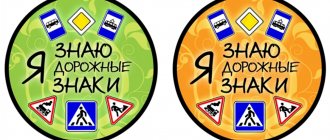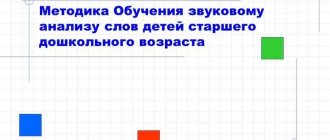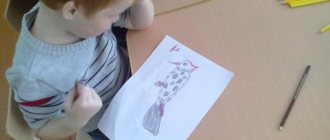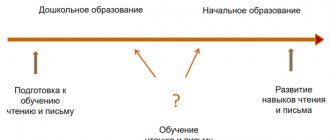Preparation and teaching of literacy in the system of kindergarten work on speech development
Literacy training is carried out across all age groups.
In the 2nd junior group
– this is preparatory work for mastering literacy, it forms the following tasks:
1. Identify the level of development of phonemic hearing in children; develop auditory and speech attention; work on differentiating isolated sounds.
2. Introducing children to the vowels of the 1st group, plus the sound [and], as well as their implementation: in speech - with sound, in writing - with a printed letter.
3. General familiarization of children with the concepts of “sound” and “word”.
In the middle group:
1. Children continue to become familiar with the individual characteristics of children’s sound pronunciation.
2. Introducing children to the vowels of the 2nd group and consonant sounds, as well as the differentiation of sounds in words and in phrasal speech.
3. Children continue to become familiar with the concept of linearity and length of words, duration of sound.
In the senior group:
1. The transition from the ability to recognize and pronounce sounds to the ability to synthesize syllables and words from them.
2. This is the stage of directly teaching children to read (syllabic smooth reading - up to 15 characters) and the development of coherent speech.
3. Work on logical, phrasal, psychological and emphatic pauses.
Preparatory group
– this is the final stage in the work of preparing children for learning to read and write, which involves the child’s understanding of the holistic model of language:
from sound - to syllable;
from a syllable - to a word;
from a word to a sentence;
from the sentence to the text, literature.
Municipal state preschool educational institution
kindergarten "Fairy Tale"
Preparation and teaching of literacy in the system of kindergarten work on speech development
Teacher speech therapist:
Kotsolapenko G.V.
The issues of preparing kindergarten students for school are becoming increasingly important. They are especially relevant nowadays
the time when the content of primary education changed. The school is interested in ensuring that children entering first grade are well prepared for learning to read and write, that is, they have developed phonemic (speech) hearing, good oral speech, correctly developed initial skills in composing and analyzing sentences, and dividing words on syllables, knew how to hold a pencil and distinguish lines in a notebook. Children who have received such training will easily and fluently master the process of reading and writing at school.
K. D. Ushinsky proposed a new teaching method - from sound to letter
, thus developed an analytical-synthetic method that ensured conscious
learning to read
rather than rote memorization.
The basis for teaching literacy
is the general speech development of children.
Therefore, in preparation for learning to read and write,
the entire process of speech development of children in
kindergarten
- the development of coherent speech, vocabulary,
grammatical structure
, sound culture of speech. Research and teacher experience have shown that children with well-developed speech successfully
become literate
and all other academic subjects.
Taking into account the characteristics of children, material on teaching literacy
it is necessary to give synchronously to different channels
of perception (visual, auditory, tactile, kinesthetic)
.
What does the tongue do when we pronounce a sound? How to check whether he is voiced or deaf? Whose song does the sound resemble? (wind, water)
Therefore, when introducing a letter, we compare it with objects, change it, turn it into another letter, into an interesting picture, depict the letter with our fingers, with our whole body, find it by touch in a bag, etc.
Difficulties in mastering reading and writing at school arise not only due to impaired phonemic hearing, but also due to difficulties in memorizing letters (their graphic representation, impaired spatial orientation, the child’s inability to coordinate the movements of the hands and fingers, impaired muscle tone of the fingers. Therefore, one One of the conditions for successful preparation for learning to read and write is preparing a child’s hand for writing
.
begin such preparation from younger groups
.
Games in younger and middle ages are aimed at developing motor coordination, mobility of the hands and fingers, as well as their strength and dexterity. At an older age - on the development of tactile sensitivity, muscle tone, the development of fine motor coordination of the hands and fingers, the formation of sensorimotor coordination, and elementary specific graphic skills. In addition, fine motor skills are the basis for the development of mental processes - attention, memory, perception
, thinking, speech, spatial concepts.
A high level of development of fine motor skills indicates the functional maturity of the cerebral cortex and the child’s psychological readiness for school. By developing motor skills, we prepare a child's hand for writing
.
Master class on teaching literacy in the middle group for educators
It is well known how complex and voluminous the Russian language program is in primary school and how difficult it is for a child who has not mastered the skills of sound analysis and word synthesis to master its course.
The preschool course for speech development and preparation for literacy is designed to ensure high-quality preparation of children for studying in primary school.
And the question arises, - When to teach? Research by Zhurova, Varentsova, and Durova showed that preschoolers need to be introduced to the sound system of their native language from the middle group of kindergarten. For four-year-old children, speech turns from a means of communication into an object of cognition and analysis.
Education in the middle group is aimed at developing phonemic awareness and speech attention of children, which prepares them for mastering the sound analysis of words - the first step in learning to read and write.
I work according to the Zhukova program. According to this method, training begins with the middle group, in the second half of the school year. In my work I pay special attention to gaming techniques and didactic games, which constitute the specifics of teaching preschoolers and are an essential component of this training.
Work on teaching literacy in kindergarten is carried out in several stages.
In the middle group this is the preparatory stage.
-I suggest you take the paper and rustle it.
- What do you hear?
Answers from teachers
- Close your eyes and listen. (I play a large and then a small tambourine)
- What did you hear?
Answers from teachers.
— We got acquainted with non-speech sounds. We form tonal sound discrimination, or in other words, noise perception. At this stage the concept of “sound” is given.
Using the following games we reinforce: “Train and Bird”, “Find out what it sounds?”, “Where does the bell sound?”, “Show the picture”, “Loud - Quiet”, “Who said it?”, “Bells”, “Elephants” and donkeys."
I suggest you play the game “Train and the Bird”. To do this we will need to split into two teams.
The first command is “Train” - will pronounce the sound “T”
The second command “Birds” - will pronounce the sound “Th”
-What do you think we will develop in children using these games?
Teachers' answers.
-The ability to intonationally highlight sounds in words, distinguish between soft and hard consonant sounds by ear, and name words with a given sound is correct.
Intonation emphasis of a sound in a word is a special pronunciation of a word when the desired sound is pronounced more drawn out (longer) or louder, more clearly than the others. Only some consonant sounds can be pronounced longer: m, r, z, v, sh, s, etc. The same consonant sounds as k, p, b, t, etc. cannot be prolonged for a long time. When intonationally highlighting a sound in a word, one sound cannot be separated from the other; the sound must be isolated in the process of pronouncing the entire word together (mmak, ramma. Domm).
Teaching preschoolers the intonation of sound in a word occurs with the help of such a methodological technique as a sample of the teacher’s pronunciation of a word, because Children of middle preschool age find it difficult to control their articulation and change it if necessary.
Learning the intonation of sounds in a word occurs only using the example of consonants. The intonation emphasis of vowels does not require the child to rearrange his articulation. Moreover, prolonged pronunciation of vowel sounds in a word leads to syllable-by-syllable pronunciation of it, which is natural for our speech. Our task is to teach the child new articulation, which performs the function of examining the sound composition of a word.
When forming the intonation selection of sound in a word, a methodical technique is used to compare speech sounds with natural sounds, calling sounds “songs” (sss-pump song, prr-motor song, shhsh-wind song, etc.), as well as during classes for children I read a short poem.
This letter is wide AND looks like a beetle. And at the same time, like a beetle, it makes a buzzing sound: Zh-zh-zh!
-I invite my colleagues to read this poem with me.
This letter is wide AND looks like a beetle. And at the same time, like a beetle, it makes a buzzing sound: Zh-zh-zh!
Having made sure that the Teachers have memorized the text, I propose to listen to the modified reading of this poem.
This letter is wide and looks like a zhzhbug. And at the same time, like a buzzing beetle, it makes a buzzing sound: Zh-zh-zh!
—Have you noticed how I read the poem just now?
Teachers' answers.
After that, I read the poem again and invite teachers to find words in it that buzz.”
Answers from teachers.
- thus, for the first time, we switch children’s attention from the semantic side of the word to its formal, sound side. It is necessary to plan lessons so that children do not highlight the same sound twice in a row. Children of this age are prone to dogmatically assimilate the instructions of an adult, therefore, highlighting the same sound in two classes, they begin to believe that only this sound can “occur most often.” And in the third lesson, when they are offered another sound for analysis, they stubbornly repeat that they again hear the sound that they encountered in the two previous lessons.
I suggest you play the game “Name the word with the sound (w). — Not all sounds in the Russian language are equally easy to distinguish: naturally, it is easier to intonationally highlight those sounds that can be drawn out (sonorant, hissing, whistling).
Next game “Find the sound (R)”
In front of you, on the easel, are object pictures, in the names of which you can hear a given sound. You will first need to name the words where the sound (P) is at the beginning of the word, in the middle, at the end.
— It is important to ensure that the highlighted sound occurs in words in different positions: at the beginning, in the middle and at the end of the word, otherwise the children will harden the method of highlighting the sound in one part of the word (usually at the beginning of the word)
Next game “Mom’s Bag”
-Mom came from the store and brought products whose names contain the sounds (M), (Мь).
You can use pictures as a hint.
- To isolate, you need to take only consonant sounds, because only with intonational selection of a consonant sound is a change in the usual articulation required.
Next game “Words-friends”
There are pictures in front of you on the easel, I am handing out pictures to you and you must find a friend - the one whose name of the picture matches the initial sound. (bow-elk, crane-beetle, juice-dog...)
— Toys, objects, pictures in the name of which have the desired sound are specially selected for the lesson, and the teacher draws the group’s attention to them. In order for children not to follow the path of mechanically listing all the objects lying on the teacher’s table, among them there should be several toys whose names do not have the required sound. Having mistakenly named the “wrong” words, listened to the teacher pronounce them and pronounced them independently with intonation emphasis, children begin to approach tasks more thoughtfully, pronounce the word first quietly, to themselves, and only after making sure the answer is correct, repeat it out loud.
So, by the time they move to the senior group of kindergarten, children as a result of this type of activity should master the following skills: 1. Be able to hear a frequently repeated sound in a poem. 2. Be able to pronounce a word or a poem, emphasizing the desired sound in it with intonation. 3. Be able to determine the place of a sound in a word. 4. Be able to independently name words with a given sound
Reflection “Bouquet of Mood”
There are blue and red flowers in front of you. If you liked the master class and learned something new, then attach a red flower to the vase, and if you didn’t like it, attach a blue one.
(I consider how many red and blue colors there are and draw conclusions):
— There are more red flowers in the vase, which means the material was useful for you, and in addition, I have prepared reminders for you with games that you can play with your children in your free time.)
- Thank you for your work. Best wishes.
Literacy lesson “Blizzard Song” in the middle group
Goal: to consolidate the correct pronunciation of sounds [v - v] in children’s speech. Objectives: 1. Develop phonemic perception and the ability to identify sounds [в - вь] in words; 2. To consolidate children’s knowledge about wild animals and their life in winter; 3. Teach children to find the first sound in words; 4. Teach children to breathe correctly through play. Material: Vera's crow toy, large pictures depicting a fox, hare, squirrel, bear, wolf; mirrors for each child; medium-sized pictures: flowers, fork, carnation, chair, bucket, bear; lumps of cotton wool - snowflakes; small pictures: grapes, bicycle, cherry, dandelion, fox, tree, star, fish, doll...; picture of sounds [v - v] (big and small tree). Progress of the lesson I. Introductory part. Children sit on rugs. — Today a crow flew to us to warm up and play with us. And her crow's name is Vera. She told me one very interesting story. Now I’ll tell you this story.
II. Main part. 1. The story of Vera the crow. * The crow Vera got bored sitting on the fence, and she decided to fly into the forest. It was already getting dark. The crow flew from one tree to another. Suddenly, the wind grew stronger, and a blizzard came into the forest. - Guys, did you hear the blizzard howling in the evening? (children's answers) She threw snow, covering the tracks of animals and birds, and howled loudly: v-v-v (children repeat after the teacher). The crow Vera found a large spreading spruce and hid on it. And the blizzard howled more and more: v-v-v (children repeat). - Guys, where does the squirrel live? (in a hollow) The squirrel feels good in a warm, dry hollow, the entrance to which she covered with her fluffy tail. She is not afraid of the blizzard (children howl). Good for the bear too. He is also not afraid of the blizzard, he sleeps and does not hear the terrible howl. - Where does the bear sleep, guys? (in the den and sucks its paw) And the fox settled comfortably in its hole, curled up in a ball, covered itself with its fluffy tail (the children howl like the wind). Even the hare dug a hole in the snowdrift and hid from the blizzard. — Guys, what color is a hare’s fur coat in winter? (white) - Why do you think the hare has a white coat in winter and gray in summer? (to hide in the snow; so that the fox and wolf do not notice him in the snow). One crow, Vera, sits, ruffled, on a spruce tree. She is cold and scared in the forest. The frost began to get stronger in the morning, and the blizzard began to subside (first the teacher, and then the children say: v-v-v). The crow calmed down, but suddenly heard, right under the spruce tree on which it was sitting, the howl of a wolf: v-v-v (children repeat). The wolf complains about his wolf life, takes offense at the blizzard, which has covered up all the hare's traces. Vera the crow got scared of the wolf and flew back to the village, to our group.* 2. Articulation of sound - children sit on chairs near the board. The teacher hands out mirrors for everyone to work with. - Children, how did the blizzard howl in the forest at night? (v-v-v) - What about in the morning? (wow) - How did the hungry wolf howl? (v-v-v) This is an interesting sound we met today. To pronounce it correctly, you need to press your lower lip to your upper teeth, raise your upper lip slightly, and your neck should tremble. When analyzing sound pronunciation, children use individual mirrors. — What sound did you learn to pronounce? Let's pronounce this sound to Vera the crow (children repeat the sounds [v and v]). 3. Working with pictures. The teacher puts pictures on the typesetting canvas (flowers, fork, carnation, chair, bucket, bear). Asks to name the objects in the pictures. - Guys, say it so that Vera the crow and I can hear the song of the blizzard [v and v]. For example: v-v-bucket. - Which picture is missing here? (chair). Why? (there is no blizzard song in this word). - Now let’s do this exercise - you need to determine the first sound in these words (flowers, fork, carnation, chair, bucket, bear). 4. Physical school (the teacher distributes cotton balls to the children). - Guys, let's play snowballs. We will play like this: you need to blow on the snowballs so that they fly far from your palm. Watch how I will do it. Inhale through your nose, and then blow forcefully onto the snowflake (children's game). - Why do we learn to breathe correctly and strongly? (to learn how to pronounce sounds correctly and clearly). 5. Game “Find the Blizzard Song” - children sit on chairs. — Vera the crow brought us pictures to play the game “Find the Blizzard Song.” The teacher distributes pictures to each child, but places them on the children’s palms with the pictures facing down. He asks them not to let anyone spy on what picture they gave him. At the teacher’s signal, the children turn over the pictures, say to themselves the name of the object that is depicted in the picture, and determine whether there is a blizzard song in this word. - Guys, who have the blizzard song in the word, who heard this song, go to the board and show the picture to all the guys. Say your word so that we can hear the song of the blizzard. All words are checked with all children. III. Bottom line. Showing a diagram of the sounds [в] and [вь] (small and large tree). - Guys, Vera the crow drew pictures of blizzards, they are different. Do you think in this picture (the big tree) how a blizzard howls? (strong - v-v-v) - Why do you think so? (a large tree is drawn). A question is asked about another picture, which shows a small tree. Then everyone sings the blizzard song in chorus: v-v-v and v-v-v. Vera really liked how you guys did this lesson. And she promises that she will fly to visit us again. Let's all tell her together “Goodbye!” Children say goodbye to the crow Vera. The teacher praises the children for their good work in class. The lesson ends.




